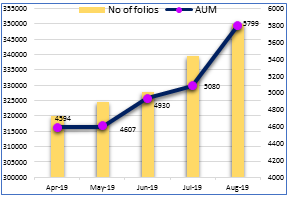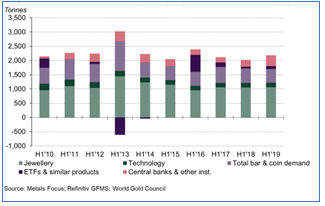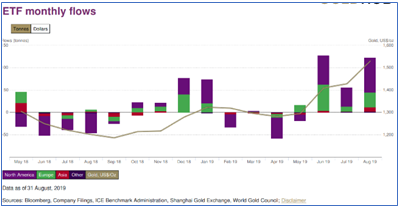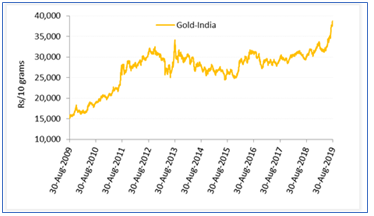 (Image source: Image by Linda Hamilton from Pixabay)
(Image source: Image by Linda Hamilton from Pixabay)
In the last one year, investment in gold has grown exponentially. From the AMFI data, the assets under management for Gold ETFs has jumped from Rs 4,434 crore on September 30, 2018 to Rs 5,798.52 crore as on September 9, 2019. Even in the past five months, it has grown as seen from the chart below.
Graph 1: Rise in folio and AUM of Gold ETFs

(Source: AMFI)
But my main concern is about why you should have taken heed of the advice from our earlier article, "Why Dumping Gold ETFs Now Is Stupid!", published a year ago for your huge gains.
Even when World Gold Council, released half-yearly data, it validated that investing in Gold would have been a wise decision. As can be seen from the below graphs, "H1 gold demand boosted to a three-year high by record central bank buying" and "Holdings of gold-backed ETFs grew 67.2t in Q2 to a six-year high of 2,548t."
|
Graph 2: Gold demand at 3-year high
 |
Graph 3: Surge in Global Gold ETFs
 |
(Source: World Gold Council)
Let me explain why this has happened, but first, let's understand the significance of gold. It is one of the oldest and most essential assets that is treated differently...
-
It has proven itself to be symbolic of wealth that carries immense value.
-
Highly liquid asset.
-
Can deliver better long-term, risk-adjusted returns.
-
An effective diversifier than other commodities.
-
Outperforms in low inflation periods.
-
Gold has lower volatility.
It basically helps deal with systemic risk, during stressful times. Gold as an asset has a negative correlation with other assets during risk-off periods, protecting the investors' capital against tail risks and other events that have an adverse impact on capital or wealth. This safety of cap is not present in other commodities or assets also.
When economic conditions are benign, there is slow consumer growth and inflationary pressure, it works in gold's favour. During these times, however, market participants try to safeguard their capital against extreme losses and choose assets like gold. This increases gold investment demand and drives up the gold prices. Hence, it is one of the most sought-after safe havens.
In the last year, there have been instances, on the global front and at the domestic level that has surged the gold demand...
-
✓ Most of the year saw Rupee depreciation against the US dollar.
-
✓ The constant rate hike by the Federal Reserve board members saw flattish yield curve which made them change the monetary policy stance to "Easy".
-
✓ Further a potential fresh round of stimulus by ECB.
-
✓ A slowdown in global growth has pushed the economy in a recessionary mode.
-
✓ Central banks from the emerging markets including India and China has sensed the need for quantitative easing, hence increased gold holdings as rate cuts didn’t help to reinvigorate the global economy. And even the Bank of Japan is expected to make policy more accommodative.
-
✓ The European Central Bank's (ECB) recent accountments hinted at measures of bond purchase or rate cuts to sustain economic growth.
-
✓ Potential upside risk to retail inflation.
-
✓ Spat between the US and China over trade remains unresolved.
-
✓ Trade war tensions between the US and other economies.
-
✓ Ongoing geopolitical tensions between the US and Iran.
-
✓ Rising crude oil prices.
-
✓ Price momentum and positioning fuelled rallies and created pullbacks, as investors continuously reassessed their expectations based on new information.
-
✓ Continued uncertainty surrounding Brexit timing and implications.
Even the IMF Global Financial Stability report highlights an increase in the level of risk among multiple global metrics and therefore the importance of owning gold in one's portfolio. So, if you had invested in any one of the Gold ETFs a year ago, you would have seen a growth in your portfolio, despite volatile conditions.
As seen from the Table below, the category average returns, (and individually as well) most of the Gold ETFs have outperformed the benchmark within a range of 3.6 % to 3%. And among long time periods, except 3 years, the performance has been good, indicating that gold as an asset class does provide better returns if invested with a longer investment horizon.
Table: Gold ETFs have outperformed the benchmark
Rolling returns are taken as on September 25, 2019
(Source: ACE MF)
[Read: Here's Why You Should Allocate Some Portion to Gold ETFs In 2019]
Will gold continue to exhibit sheen going forward?
Due to global demand in gold, the prices surged and demand for consumers in India slumped --purchase of jewellery. But going ahead the demand may pick up from the onset of the auspicious muhurat of Dussehra, and thereafter Diwali to develop buying interest that would continue till the wedding muhurats in November and December.
Even the Economic Times reported Mr Surendra Mehta, national secretary of the India Bullion & Jewellers Association, views: "However, with price settling at ₹37,000-38,000 per 10 gm, everyone is hoping that from Navratri, things will be better."
The long-term secular uptrend exhibited by gold is something that invites attention and highlights the importance of owning gold in the portfolio with a longer investment horizon.
The quantum of demand, particularly in the rural regions will be hinged on the farm income. Gold will continue to be one of the most sought-after avenues to park hard-earned money. As WGC points out, gold has a central role in the country's culture, considered a store of value, a symbol of wealth and status and a fundamental part of many rituals.
WGC has projected India's gold consumption in 2019 in the range of 750-850 tonnes versus 760.4 tonnes last year. Over the last 10 years, India's average demand has been 838 tonnes.
The WGC believes the broad structural economic reforms being implemented in both India and China will likely support long-term gold demand. Plus, the gold demand by central banks in the emerging markets is likely to remain positive in the foreseeable future.
However, one can't eliminate the apprehensions of slower global growth, which continues to plague the overall economy, will provide support to inflated gold prices.
Graph 4: Gold sheen will continue

Data as of August 30, 2019
(Source: MCX)
Investing in gold in paper form can prove to be more effective. One should consider allocating at least 5-10% of your entire investment portfolio to gold and holding it with a long-term investment horizon will prove to be sensible and a smart investment strategy.
Avoid a speculative approach while investing in gold. Look at it as a portfolio diversifier and a monetary asset (rather than a mere commodity), which can help you reduce risk to your overall portfolio with its trait of being a store of value in times of uncertainties. Ideally, invest in gold with a longer investment horizon.
Thus, as Dr Duvvuri Subbarao (Ex RBI Governor) quotes "Gold is a good long-term investment and a reliable reserve asset."
PS: The last few years have not been among the best for equity mutual funds. While most funds have underperformed or are struggling to match the returns of the benchmark, there are few funds that have the potential to constantly generate alpha for its investors.
Based on PersonalFN's special 'SMART Alpha' methodology, we present our latest exclusive - The Alpha Funds Report - 2019 through which we have identified five high alpha generating funds.
Do not miss our latest research finding. Get your access to this exclusive report, right here!
Add Comments